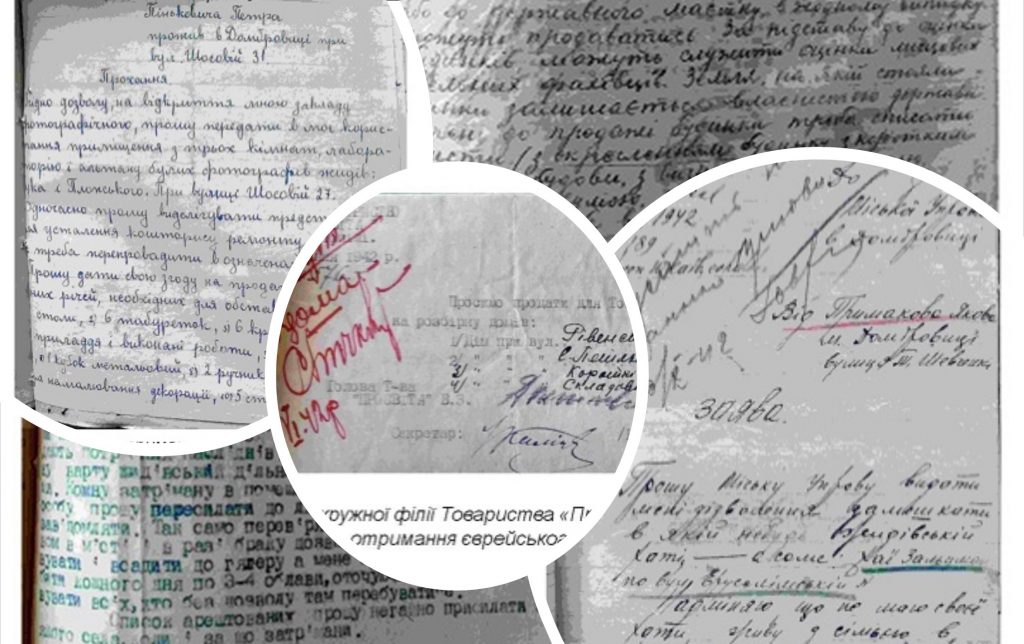Beneficiaries of the Holocaust: The Role of “Neighbors” in the Plunder of Jewish Property in Volyn during the Nazi Occupation
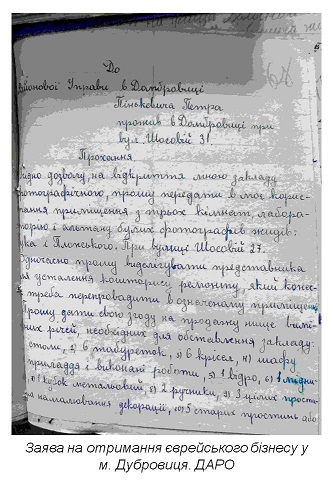 To the
To the
Raion Administration
in Dąbrowica!
The request
of Pinkevych, Petro, who
resides in Dąbrowica
on 31 Shosova Street
In keeping with permission granted to me to open a photography establishment, I request the transfer, for my use, of the premises with three rooms, a laboratory, and a gazebo formerly belonging to Jewish photographers...on 27 Shosova Street. At the same time, I request that a representative be appointed to draw up an estimate for renovations that must, of course, be carried out in the indicated premises. Please grant your agreement to the sale of the below-exchanged items that are necessary for furnishing the establishment: 2 tables, 6 stools, 6 chairs, a cabinet, equipment, and completed work, 1 pail, 1 metal cup, 3 whole sheets for painting decorations, 5 old sheets or pillowcases for making curtains for underneath the glass roof.
Dąbrowica, 3 November 1942
S. (signature)[1].
This application was submitted to the municipal administration of the small Volynian town of Dubrovytsia (before the occupation it was called Dąbrowica) one and a half months after the liquidation of its ghetto. This is but one of nearly seventy applications that are stored in the State Archive of Rivne Oblast and which were submitted by individuals eager to take possession of the properties and businesses of Holocaust victims in this town. Such applications, submitted in Volyn, number in the hundreds and thousands. The collections of the Dubrovytsia and Kostopil municipal administrations and the Korets raion [district] administration alone contain nearly five hundred applications to acquire the property of Holocaust victims, which were submitted in 1941–1942. These papers are the remnants of the documentary evidence that survived after the end of the Second World War. Applications for Jewish property were written not only by individuals but also by representatives of institutions that operated in the region. For example, in the town of Kostopil, this type of application was submitted by the local fire brigade, which was staffed by Ukrainians, Poles, and Volksdeutsche (ethnic Germans who lived in the region).[2]. In Korets, some of the property belonging to murdered ghetto victims was acquired by the Ukrainian cultural organization known as the Prosvita Society, schools, and even Ukrainian Orthodox parishes.[3]. At the same time, there is not a single documentary record of the spontaneous robberies of Holocaust victims. This article deals only with the practice involving the trade in murdered Jews’ properties, which was “legalized” by the German occupation regime.
Helping Jews in the Nazi-occupied territories of the USSR and Poland was punishable by death. Thus, one can understand why the local population was afraid to come to the aid of Holocaust victims. However, another factor must be considered—material benefit, which prompted part of the population to take part in the Holocaust. In a variety of ways, this type of behavior affected the victims’ chances of surviving.
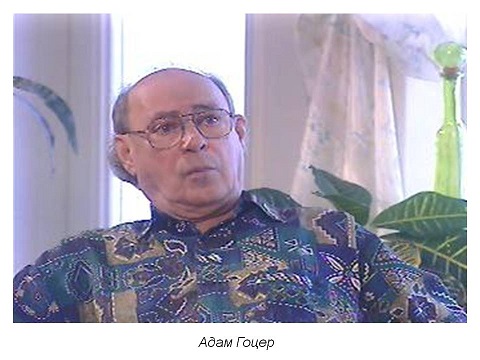
Robbing Holocaust Victims during the Formation of the Occupation Regime
By early July 1941, rapidly advancing German troops had already captured the better part of western Volyn, particularly Kostopil, Korets, and Dubrovytsia. At this stage, a number of pogromist operations took place in the occupied territories. A considerable number of them were sparked by the desire of the local populace to rob their Jewish neighbors.
Edna Eizenstein, who survived the pogrom in Kostopil, recalls how local residents, uttering the words, “You don’t need this anymore—you’re going to die anyway,” plundered her grandfather’s house.[4].
Anti-Jewish pogroms organized on the initiative of the German army took place in Dubrovytsia and Korets. Edith Kimelman, from the village of Rasnyk, near Dubrovytsia, recounted that during the bombardment, she, a little girl at the time, fled into a field with her mother. After they returned, they found their house looted, most of their valuables and furniture having been removed. Mrs. Kimelman later bumped into her Ukrainian girlfriend, Liusia, on the street, wearing her dress. To her demand that the article of clothing be returned, Liusia replied, “This is not your dress now, it’s mine. My parents said that Jews are now forbidden to own anything.”[5]. Edith remembers that right after the robbery, the Ukrainian auxiliary police set up their offices in the living room and one of the bedrooms of their house.
Manya Feldman remembers well the plunder of Jewish property in Dubrovytsia in July 1941. According to her, it was orchestrated by the newly arrived German troops, who allowed the non-Jewish population to rob Jewish homes with impunity. “They gave the non-Jewish populace unrestricted freedom to go and rob, grab, steal, and take everything that their heart desired in Jewish homes. And they did this. They robbed. They grabbed everything that they got their hands on in your house. However, the Germans issued an order stating that you could rob only until midnight. Afterwards, this had to stop,” Mrs. Feldman recounts.[6]. She recalls several ways that the Jews of Dubrovytsia were robbed, which included the seizure of valuables and confiscation of victims’ personal belongings. Whereas precious metals, requisitioned by indemnity, almost always ended up in the hands of the German administration, personal property, such as furniture, could prove useful to local auxiliary police units or their relatives.
Immediately after the arrival of the Nazi troops in Korets, Jewish homes were robbed.[7]. This was the first stage in the plunder of Jewish property—occasionally spontaneous and sometimes coordinated with the Nazi occupation regime—by their Ukrainian neighbors.
Additional measures by the occupation regime that played in favor of the local peasants included trade restrictions placed on Jews. Grigorii Kharvash, from Korets, recalls that Jews were permitted to shop at the market only on Thursdays, from 8:00 to 10:00 in the morning.[8]. Archival documents also indicate that Jews had limited access to markets. Another directive, dated 6 August 1941, states that Jews were allowed to engage in trade from 10:00 a.m. to noon.[9]. Around this time a similar situation was unfolding in Dubrovytsia. These initial economic restrictions exacerbated relations between Jews and the local population. In need of food and without a chance to acquire it, Jews were prepared to resort to unequal exchanges. They bartered their gold and other valuables as well as clothing for food. Local Ukrainians and Poles derived great benefits from this. Trade developed both during the hours at the marketplace permitted by the Nazi regime and on the black market (which eventually flourished during the existence of the ghetto). Avram Anapol′skii, from the city of Korets, recalls: “Everyone had something. People from the nearest villages came in; they might give a cup of millet for a pillow. For shoes, for a nice dress, a coat—a bin of potatoes (four or five kilos); for children, a half-liter of milk.”[10].
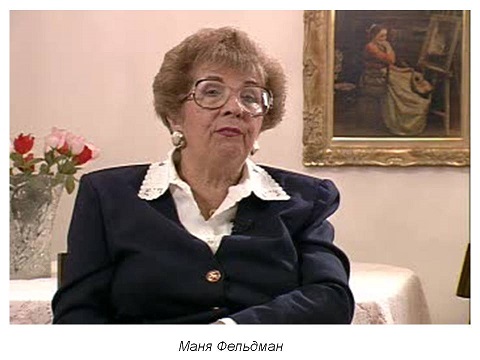
The first mass killings of Jews in Korets and Kostopil took place in the summer of 1941. On 16 August, 460 men and 20 women were shot in the town of Kostopil. The Nazi administration duped the relatives of those who had been killed. Informing them that they had been sent to labor camps, the Germans encouraged their families and friends to send them money, which was then confiscated by German functionaries.[11]. As a result of two operations that were carried out in the summer of 1941, over 470 Jews were killed in Korets. The same tactic of duping victims’ relatives was used here as in Kostopil. Nathan Skaletzky, from Korets, recalls the first operation, during which 120 members of the local intelligentsia were shot. “At first, they drew up a list of the cleverest 120 Jewish businessmen. They told them that they want to take them for work. They came and took them away. The latter were held in some place and forced to write letters saying that they are working in a camp and that they need food and clothing. Later they killed these 120 cleverest people. And in the next few months, they [the Germans] came to these people’s homes, showed letters, and said that the people are working and they need clothing. The women gathered up clothing and walked forty miles, and the Ukrainian police were expecting them; they beat them and took away the clothing. They did this two times.”[12].
Nathan Skaletzky talks about Ukrainian auxiliary policemen, who seized things from victims’ families. However, it is difficult to determine what proportion of this property passed into German hands. Be that as it may, in such situations officials of the auxiliary police were also able to appropriate something for themselves, as their detachments were almost always involved in organizing killings (like firing squads, or perimeter guards). Simon Stemer, who was in Kostopil around the summer and fall of 1941, described the conduct of the auxiliary police during one operation: “The Ukrainian police arrived and began taking away nice things, jackets. They took this, and we were just sitting there. A few hours later other Ukrainians arrived, and they searched for things, but there was nothing left to take. We sat there and realized that they would kill us soon.”[13].
Between September and November 1941 the number of mass killings increased. The process of setting up the ghetto was launched at the same time. This indirectly created advantageous conditions for the local population to obtain material benefits.
The ghetto in Kostopil was established on 5 October 1941. Victims were given only three days to move, and on 10 October 1941, the municipal administration of the town of Kostopil issued order no. 70 concerning the sale of clothing and footwear left behind by the Jews. In the order, the leadership of the Kostopil municipal administration instructed the “manager of the municipal movie theater, Mr. Andrii Zinchuk, to set about selling, on 13 October 1941, the sale of warehoused clothing and footwear to citizens who appear bearing permission slips from the municipal administration.”[14]. Thus, the property of Jews who had been moved to the ghetto was collected in the movie theater, and its manager was made responsible for the sale. This is one of those cases where even people who during the occupation seemingly held positions that had no connection to crimes became cogs in the machinery of the Holocaust.
The archives of the Kostopil municipal administration contain 105 applications from citizens requesting permission to acquire the belongings of Holocaust victims. Among them are seventy-one applications to acquire the clothing and footwear of the Kostopil Jews, who were moved to the ghetto.[15].
A considerable number of employees of the municipal administration, the body responsible for the sale of Jewish property, also benefited from the opportunity to acquire Jewish belongings. Among the applications are seventeen from employees of the Kostopil municipal and raion administrations and their structural subdivisions. In addition, a large number of applications was submitted by workers employed at the state sawmill.
Most of the applications are dated October 1941. However, applications continued to arrive in November and December, by which time approximately fifteen hundred Kostopil Jews had been shot during one of the largest operations in Volyn in the fall of 1941.
After the ghetto was created, a considerable number of Korets Jews remained in their homes and managed to hold onto their belongings (at least those who had not been robbed during the pogrom or episodes of police brutality). Thus, the large-scale trade in Jewish property in the city was not part of the raion administration’s agenda in 1941.
In late 1941 the Jews of Dubrovytsia were still living in their homes as the occupation authorities had not yet created a ghetto. On 14 April 1942, the Gebietskommissar of Sarny issued directive no. 489 about the creation of a ghetto in Dubrovytsia. In Dubrovytsia the first large-scale, “legal” robbery of victims was connected with the “housing question.”
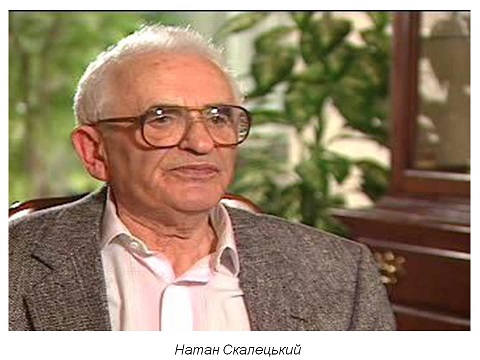
As soon as the ghetto was created in early May 1942, most of the houses abandoned by Jews were acquired by new owners. This happened even before the Reichskommissar granted official permission for the sale of Jewish real estate in June 1942. The archival collections of the Dubrovytsia municipal administration contain a register of transfers of these properties to new owners. Among those who benefited from the persecution and killing of Jews were not just individuals but legal entities as well. Not only were residential buildings sold but also enterprises, shops, and Jewish tradesmen’s workshops (shops, smithies, warehouses, etc.).[16].
Although the ghetto in Kostopil was created much earlier than those in Korets and Dubrovytsia, the question of real estate abandoned by its inhabitants was not officially regulated until the end of 1941. At least formally, all buildings that had belonged to the Jews of Kostopil remained the property of the state until June 1942. The legalized appropriation of semi-ruined homes of Kostopil Jews who had been sent to the ghetto took place in June and July 1942, almost simultaneously with the same process in the city of Korets.
In June 1942 the Reichskommissar approved a decision concerning the sale of only those buildings that were in a semi-ruined state and thus were in violation of emergency safety standards. On 11 June 1942, the Gebietskommissariats sent local municipal and raion administrations an explanation to the effect that they were assigned the task of selling such Jewish homes.[17].
By then, the first Korets ghetto had already been liquidated (21 May 1942). Immediately after the above-mentioned directive was sent to the municipal administrations of Kostopil and Korets, a number of orders arrived with a request to permit the acquisition of semi-ruined houses, which would be dismantled for building materials. In the second half of 1942, the residents of Kostopil submitted thirty-four applications.
Most of the petitioners were individuals, while some were legal entities. In the lands of western Volyn, Ukrainians were legally permitted to support the activities of their educational and cultural organizations during the Nazi occupation. One of these organizations also took part in the purchase of properties belonging to Holocaust victims. For example, an application was submitted by the district branch of the Prosvita Society.
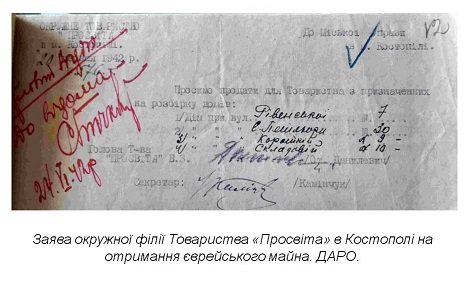
Prosvita in the town of Kostopil[18].
20 June 1942
To the Kostopil Municipal Administration
We request that you sell the following houses designated for dismantling for the Society:
1) The house at 7 Rivnenska Street.
2) 30 S. Petliura Street.
3) 9 Koretska Street.
4) 10 Skladova Street.
Head of the Prosvita Society (Danylevych, signature). Secretary (Kaminchuk, signature).
The majority of applications were submitted by individuals—residents of Kostopil. The inhabitants of surrounding villages did not take an active part in the distribution of Jewish property belonging to Holocaust victims. By gender, most of the applicants were men.[19].
The Plunder of Holocaust Victims during the Existence and Liquidation of the Ghetto
One way for peasants to acquire valuable articles was to barter food for clothing and valuables, a practice that was nearly ubiquitous, despite the severe penalties that people risked by engaging in such operations.
The Kostopil ghetto was divided into three sections: the labor camp; the central part of the ghetto; and a fenced-off area for “privileged’ Jews (tradesmen, members of the Judenrat, and policemen, along with their families). Given the catastrophic food situation, a worker’s daily ration in the Kostopil ghetto consisted of two hundred grams of bread. The ration was two times smaller for women and children; the latter group had the greatest opportunities for arranging illegal bartering with the local population: clothing and valuables exchanged for food.[20]. Jews were thus swindled out of everything that they still owned after they were sent to the ghetto.
The situation in Korets and Dubrovytsia was similar. In Dubrovytsia the ghetto was established quite late. It was an open-type one, without a fence, and the regimen of supervision outside the perimeter of the ghetto was eased, which significantly facilitated ghetto prisoner trade with peasants. Local Jews even managed to trade with the owner of the local mill.
The auxiliary police also earned money from such prohibited trading operations. “People tried through policemen. You offered a pair of shoes, and he would bring you a few potatoes, a little vegetable oil, a little cottage cheese. In general, however they were able,” recalls Grigorii Kharvash, who was from Korets.[21]. However, a person needed to own a lot of valuables in order to obtain food constantly. Avram Anapol′skii talked about the starvation that swept through the Korets ghetto in 1941–1942, when the Jews’ supplies of valuables were depleted and there was nothing left with which to barter for food.[22]. Anapol′skii was a child at the time, and his parents asked him to look for food outside the ghetto. At the time, children were actively used for this purpose in many ghettos in Volyn. Sometimes local peasants hired them to work as shepherds, and they would sneak out of the ghetto. They had an opportunity to obtain food, which they brought to their families every evening.
Peasants themselves went to the ghetto in order to barter food for articles they deemed valuable. This was strictly prohibited but few were deterred. We know about the illegal visits of Ukrainian peasants to ghettos from the correspondence between the Korets raion administration and the local commandant’s office of the auxiliary police.[23]. This correspondence dates to early September 1942, that is, to the period when the second, closed-type, ghetto was still in operation.
In Dubrovytsia and Korets, Jews were used for forced labor not just by the Nazi occupation authorities but also by local Ukrainians, who hired Jews to work in the fields (digging potatoes, gathering other crops, etc.) in rural areas where there were no large enterprises or significant numbers of German administrators. “We could go to work for gentiles in the fields, in order to earn something, eat something. We traded a lot, bartering clothing (blouses, shirts) for food. But how much you needed in order to barter!” Fania Wedro recalls.[24].
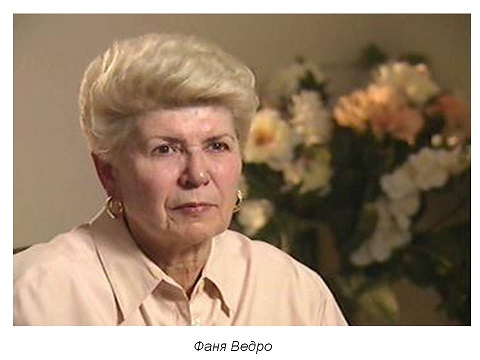
Sometimes local administrations also used Jewish labor to benefit the Ukrainian community. There are no documents confirming that this happened in the places which were researched for this article. However, there is extant evidence revealing that the Mlyniv raion administration used Jewish labor to repair schools.[25]. A directive issued by the Klevan Gebietskommissariat attests that Jews periodically performed forced labor for peasants.[26]. Such forms of economic interaction frequently offered victims the only chance to obtain essential food items.
The next surge in the large-scale plunder of Jewish property took place when the ghetto was being liquidated (summer–fall 1942). The appropriation of Jewish property took place by both “legal” means—purchasing them from municipal administrations—and spontaneous robberies. The latter were prevalent. For example, the Jews of Dubrovytsia were transported by train to Sarny. Manya Feldman recalls these events: “At the time, Jews tried to escape from the train; they jumped out of the cars. They were shot at. Some were able to dodge a bullet, but many were shot. At this time several local residents went into the woods in order to rob the Jews. They knew that Jews were fleeing the ghetto and had with them some valuables or money.”[27].
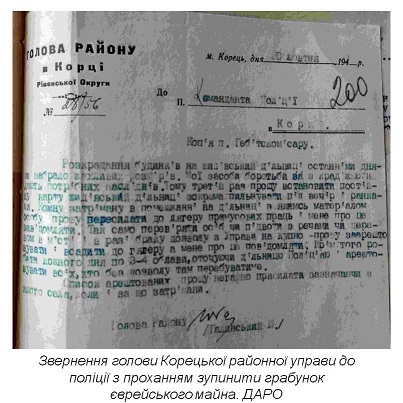
Very telling in this context was the liquidation of the ghetto in Korets. The first operation took place on 21 May 1942. The remnants of the re-established ghetto were destroyed on 25 September of that year (the ghetto was re-established in order to lure out those victims that had managed to evade the first liquidation operation; the victims were promised that they would have a further peaceful existence). During the first liquidation operation, near the village of Kozak, the Nazis shot approximately 2,500 Jews. While these killings were being organized and for several days afterwards, peasants mercilessly looted the homes of Holocaust victims. Sixteen-year-old Fania Wedro survived because she was deemed fit for work; her mother and other family members were shot. When she came back home that day, Fania found a nearly empty house; belongings from the house had been removed by someone who was very close to her—a female Polish neighbor.[28].
Since Fania had been robbed during the first liquidation operation, it was difficult for her to survive in the second Korets ghetto. But this was by far not the only consequence of the robberies that affected the lives of those who had been able to evade the killings. Property-hunters searched for valuables no less meticulously than the Germans and policemen, who combed through houses in order to find Jews who were hiding. This is attested by a number of recollections. A substantial number of eyewitnesses noted that they were discovered in their home-based hiding places not by Germans but by these property-hunters. After discovering victims, they would call the police, shouting that they had found some Jews.[29].
The next surge in spontaneous robberies in Korets took place during the final liquidation of the ghetto on 25 September. The correspondence between the raion administration and the police commandant’s office reveals what was happening in the ghetto in the immediate aftermath of its destruction. The auxiliary police were none too keen on helping the raion administration when the latter requested that the acts of robbery be stopped and that the police provide protection for the houses located on the territory of the now-liquidated ghetto. The head of the raion administration managed to get a response from the auxiliary police only after he sent an appeal to the Gebietskommissar of Rivne.[30].
The mass looting was followed by a period marked by the legal sale of Jewish property. No applications for clothing have been preserved in the collections of the Korets raion administration, unlike in the Kostopil administration. However, from the testimonies of eyewitnesses, it is clear that the raion administration amassed a substantial amount of clothing belonging to murdered Jews. Anapol′skii recalls that an immense quantity of articles belonging to Jews who were shot in the village of Kozak was delivered to the courtyard of one of the administration buildings.[31].
Efforts to uncover documentary evidence of how this clothing was sold failed. However, a number of applications to acquire the semi-ruined homes of murdered victims have been preserved. The explanation offered by the Gebietskommissariat of Rivne about the sale of these houses to the Korets raion administration is dated 11 June 1942.[32].
Throughout June, July, and August the Korets raion administration received dozens of applications for the acquisition of semi-ruined Jewish homes that were slated to be dismantled for building materials.[33]. Besides individuals, Ukrainian organizations figure here once again. For example, the church council of the main Orthodox parish in the city of Korets submitted a request to be granted essential building materials to repair the parish house in the village of Holovnytsia.[34]. Just like in Kostopil, several applications from the branch of the Prosvita Society were discovered. However, these were not applications for building materials but the personal belongings of Holocaust victims: a piano, furniture, and the like.[35].
A considerable number of applications were submitted by the auxiliary police as well as court and other administrative instances, requesting building materials and furniture for outfitting their offices. [36].
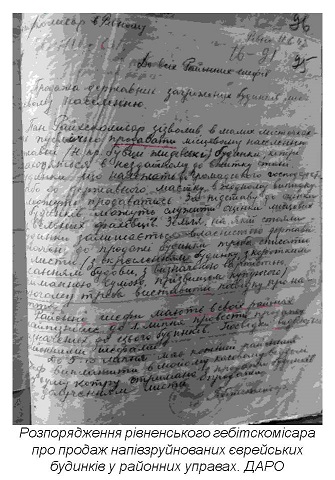
In Korets, benefits were gained not only by the town residents (as in Kostopil) but also by the inhabitants of surrounding villages. Adam Hotser recalls that quite a few employees of the occupation administration from villages acquired Jewish homes in cities.[37].
Most of the 262 applications were written by male individuals.[38]. Among the Ukrainian organizations waiting in line for Jewish property, the most active applicants were branches of the Prosvita Society and local schools; the largest number of applications came from them.
The liquidation of the ghettos in Dubrovytsia and Kostopil was followed by yet another sale of property belonging to Holocaust victims, for which the local municipal administrations took responsibility. Unfortunately, the applications for these properties are not extant.
On 26 August the ghetto in Dubrovytsia was liquidated, and the “real estate market” went into action once again. Between August and December 1942 the residents of Dubrovytsia and surrounding villages submitted eighty-six applications requesting permission to acquire residential buildings and tradesman tools belonging to murdered Jews.[39].
It seems that the people who benefited most from the liquidation of the ghetto were those who submitted requests to obtain accommodations for their business activities. For them, the mass killings created new opportunities for social mobility in the poorly developed region, where, apart from squeezing its Jewish neighbors, the local population had practically no opportunities to become entrepreneurs.
To a certain extent, the applications to acquire movable and immovable property, which were written immediately after the liquidation of the ghettos or the mass shootings, were an act legitimizing the killings. Some people may well have expected the killing of their Jewish neighbors in order to acquire their property. Thus, at the very least they had no desire to thwart this large-scale crime in any way. On their applications, petitioners recorded their addresses, which reveal that they often lived on the very same streets as the Jews whose houses they were requesting to be transferred to their ownership. In other words, they were neighbors in both a symbolic and literal sense. They had known the murdered people before the Holocaust, having lived side by side with them for decades.
The Survival of Victims outside the Ghetto
At various stages of the genocide, a considerable number of Jews escaped from the ghettos, the sites of shootings, and on the eve of mass killings, and hid in the homes of their gentile neighbors or alone in the surrounding woods or other places.
Research of this question reveals that it is difficult to follow a clear chronological sequence because eyewitness testimonies are the main source of information. In this case, therefore, instead of a chronological narrative, it is more expedient to establish multiple contexts out of which I elucidate the economic motives underpinning the behavior of the local population, namely: accepting things from Jews for safekeeping; exploiting Jewish labor in exchange for food and/or shelter; saving Jews for money; and participating in the hunt for Jews in exchange for a reward. I will examine each of the contexts in detail.
Given the waves of robberies and constant contributions that the occupation authorities imposed on Jews, a considerable number of Holocaust victims gave their belongings to their neighbors for safekeeping before moving to the ghetto. If some of them managed to avoid death and escape from the ghetto, their survival depended on whether their neighbors agreed to return their property. Fania Wedro recounted that her parents left several things with a female neighbor before they moved to the Korets ghetto. When the operation took place on 25 September 1942, Fania was able to escape. She did not know where to go and decided to pick up her belongings from her neighbor. The latter returned several valuables that later helped Fania pay for food and a hiding place.[40].
However, not everyone behaved as honorably as Fania’s neighbor. Nathan Skaletzky, who also escaped the reprisals during the liquidation of the Korets ghetto, recounts how he almost died because of his male neighbor, with whom he left many things for safekeeping.[41].
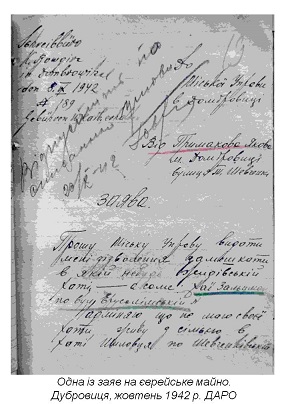
Similar stories are recounted by Jews who, after escaping, hid in rural areas. There they encountered a variety of problems, the gravest one being the need for food and shelter. They were able to satisfy both of these needs by offering peasants their valuables in exchange. Even Righteous Among the Nations, who provided help without material reward, needed resources in order to feed those whom they were rescuing. This was stated by the Righteous Yuliia Rakovych and Maksym Vashchyshyn, whose parents helped several Jews survive in a rural area near Dubrovytsia.[42].
People often ventured to help Jews in exchange for material recompense. The Polish historian Jan Grabowski, who researched this phenomenon in the occupied Polish territories, concluded that deliverance in exchange for money was very unreliable and significantly lowered the chances of surviving. He was referring to a specific type of behavior displayed by neighbors of Jews: turning rescuing into a business. At the first sign of a threat or when Jews’ funds were depleted, such “rescuers” abandoned the victims to fend for themselves.[43]. If, however, they honored their previously agreed-upon obligations and did not change the terms of the “contract” in a one-sided way, this could even help victims to survive.
The historian Icchak Cukierman[44] divides the people who aided Jews for money into several categories: those who continued to help even when the victims’ financial resources were depleted; those who supported Jews as long as they kept paying, sooner or later forcing them to leave; and those who hid Jews while they still had money and eventually handed them over to the occupation authorities (often in order to earn a “final” reward)[45]. To this list must be added another category of paid rescuer: those who robbed victims and singlehandedly killed them, in order to avoid uncomfortable questions from the occupation authorities.
Adam Hotser remembers peasants who turned rescuing into a way of pumping out all possible valuables that the fugitives still owned after the second Korets ghetto was liquidated.[46]. Grigorii Kharvash likens hiding in peasants’ homes to a market of services, where one’s financial capacity had to be considered:
“Money was running out, and we began looking for partisans or another place that would be cheaper. And we found one. We were in Kruhlyk, in a village, and farther away was the village of Józefówka. And we moved there.”[47]. At first, a Polish woman hid him and another Jew for money; later, Ukrainian peasants. In other words, people still extended a helping hand and offered at least some chance of survival.
After the liquidation of the ghetto, many Jews were left with nothing, so they were likely to offer their skills. “Some people went to orchards and gardens and stole tomatoes, potatoes, and other things. My sister and I did not do this. But since we knew how to embroider, we went around to houses asking for work. Past the river we were already far away from the Germans. We looked after children, embroidered, cleaned, tended cattle,” recalls Rachael Rubin about surviving in a rural locale near Korets.[48]. Klara Garmel, who was also in hiding there, worked as a servant girl for Ukrainians and Poles. She changed masters over ten times and finally, pretending to be a Ukrainian woman, married an older man. That is how she was able to survive the occupation.[49].
The above-described examples of economic interaction with the local population helped Jews to survive. In their memoirs, Holocaust victims who hid near Stepan (Gebiet “Kostopil”) described a completely different situation. Shmul Tantsman and Harry Magid recount one and the same story: In 1943 members of the Ukrainian Insurgent Army lured out of the wood some Jewish tradesmen who were hiding there. The UPA needed doctors, dentists, bootmakers, and shoemakers. So they offered Jews with these skills food and shelter in exchange for their services. According to eyewitnesses, when the Soviet army was advancing in 1944, the members of the UPA shot all these Jews. A similar account is offered by Vera Shchetinkova, who also hid in the woods near Stepan.[50].
The most cynical individuals were Jew-hunters, who exposed Jews in order to obtain some kind of benefit. The Nazi occupation authorities encouraged such behavior. In rural areas, there were hardly any German soldiers and gendarmes. Thus, members of the auxiliary police and village elders became the eyes and ears of the regime. If someone denounced hidden Jews, s/he informed the village elder about this, he, in turn, informed the auxiliary police. Policemen then instituted reprisals or involved German gendarmes in such an action. However, here and there peasants themselves killed Jews, so as not to share their property with policemen or gendarmes. Policemen acted similarly when they declined to inform the German gendarmerie. If peasants wanted to obtain a reward because the victim did not own anything of value, they informed the police or the elder. For this, they were given a kilogram of salt, alcohol, or fuel.
Avram Anapol′skii, who stayed with a Ukrainian family that extended a helping hand to him, recalls the following: “We warmed ourselves up and were told not to show our faces here in the villages because in every village there are policemen, elders, and there is an authorized representative of the commandant’s office, who collects milk. And on every fence it was written that whoever hides a Jew or helps a Jew, the entire family will be shot and the house will be burned. Whoever helps to hand over a Jew to the local authorities will obtain a pood of salt, Deutschmarks, and a cow.”[51].
Recounting the liquidation of the Dubrovytsia ghetto, Manya Feldman notes: “When the Jews were being led approximately two kilometers to the railway station, they escaped. They were caught in fields; other local residents also captured Jews and returned them to the Germans. And the Germans gave them some sugar and salt as a reward. They announced that a reward would be received for every Jew who was brought in.” [52].
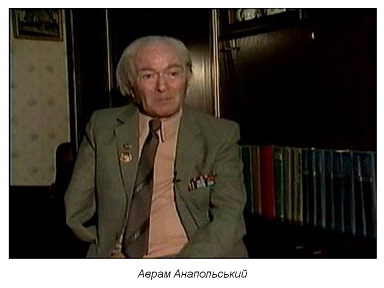
Officials of the auxiliary police had a considerable number of opportunities to obtain benefits from hunting down Jews among the local population. Eyewitnesses frequently note the material motive behind their actions. Sometimes policemen yielded very easily to the temptation to receive a bribe. It sometimes happened that the border between hunters and rescuers ran through one and the same family. Vera Shchetinkova recounts the following situation. A family gave her shelter and promised to hide her, but the owner’s nephew, upon discovering her hiding place, tried to shoot the Jewish woman. Vera managed to buy him off with a gold coin.[53].
With the approach of the Soviet army, the behavior of some peasants began to change. Edith Kimelman notes that the material factor played a role at that time as well. ”It was very close to the Russians, who were approaching this territory. The partisans could capture entire territories and small towns. During this period the mood changed. Now they treated us well. If the partisans arrived, Ukrainians could tell them that they had been saving Jews. And they would be rewarded for this. Now we were valuable merchandise. And the peasants did not want to let us go. They said: ‘No, no, stay,’” Edith says, recounting her experience of hiding at the end of the war in a rural area of Ukrainian Polissia.[54]. It is difficult to determine how widespread this changing trend in the Volynian population’s attitude to the Jews was. We have only some eyewitness testimonies with regard to this.
Conclusions
During the Second World War, most of the Jews living in western Volyn were killed in small towns like Dubrovytsia, Korets, and Kostopil. Besides financing the German military machine and enriching Germans, the plunder of victims here was a method to legitimize the genocide among the local population by encouraging it to collaborate.
During the existence of the ghettos in Kostopil, Dubrovytsia, and Korets, the local population, above all the peasantry, actively participated in the unequal trading exchanges with Jewish prisoners. When the ghettos were being liquidated in all three towns, spontaneous robberies took place in the homes of murdered Jews. Every killing operation was followed by the commencement of trade in Jewish property (especially clothing, furniture, and real estate).
Jews managed to flee the ghetto or execution sites and hide for a time somewhere nearby. In this case, their fate depended on the attitude of the local population. As attested by Holocaust survivors, a substantial number of Ukrainian and Polish peasants, guided by material incentives, constructed diverse models of interaction with Holocaust victims. In some cases, this allowed victims to survive (assistance in exchange for valuables, bartering for food, etc.); in other cases, the only result was a catastrophe. Be that as it may, “righteous” behavior was encountered significantly less often than behavior that was motivated by economic benefits.
After being robbed, Jews lost belongings with which they could have bartered for food or paid someone to hide them. Lacking the basic means of survival, they died of cold and sickness. Jews were killed in order to rob them, handed over to the Nazi occupation authorities for a reward, etc. But the key point is that the possibility of gaining something from the mass killings laid the foundations of the legitimization of the crime in the eyes of local residents. This led to the formation of silent consensus around the belief that Jews no longer had a place in the life of communities.
People had various motivations for wanting to take possession of Jewish property. Some acted this way out of desperation, while others bettered themselves financially through their official position (police, municipal administration employees, etc.). However, their behavior usually significantly reduced the victims' chances of survival.
This text is a shortened version of an article that appeared in the journal Misto: istoriia, kul′tura, suspil′stvo (City: History, Culture, Society), no. 9 (2020): 46–87. The author’s photographs were used in this publication.
[1]. Derzhavnyi arkhiv Rivnens′koї oblasti (State Archive of Rivne Oblast; hereafter cited as DARO), f. R-293, op. 2, spr. 4, ark. 68.[2]. DARO, f. R-23, op. 1, spr. 11, ark. 18–19.
[3]. DARO, f. R-48, op. 1, spr. 35, 128 ark.; DARO, R-48, op. 1, spr. 36, 139 ark.; DARO, R-48, op. 1, spr. 37, 112 ark.
[4]. Edna Eizenstein, Interview 9486. Visual History Archive. USC Shoah Foundation Institute. Accessed online at Freie Universität Berlin in July 2019. Hereafter, all the translations of excerpts of oral histories from the English and Russian are the author’s, unless otherwise noted.
[5]. Edith Kimelman, Interview 47959. Visual History Archive. USC Shoah Foundation Institute. Accessed online at Freie Universität Berlin in July 2019.
[6]. Manya Feldman, Interview 9245. Visual History Archive. USC Shoah Foundation Institute.
[7]. Encyclopedia of Camps and Ghettos, 1933–1945, vol. 2, Ghettos in German-Occupied Eastern Europe, pt. B. (Bloomington; Indianapolis: Indiana University Press in association with the United States Holocaust Memorial Museum, 2012), 1385.
[8]. Grigorii Kharvash, Interview 45591. Visual History Archive. USC Shoah Foundation Institute. Accessed online at Freie Universität Berlin in July 2019.
[9]. DARO, f. R-48, op. 1, spr. 10, ark. 13.
[10]. Avram Anapol′skii, Interview 32206.
[11]. Encyclopedia of Camps and Ghettos, vol. 2, 1387.
[12]. Nathan Skaletzky, Interview 598. Visual History Archive. USC Shoah Foundation Institute. Accessed online at Freie Universität Berlin in July 2019.
[13]. Simon Stemer, Interview 7777. Visual History Archive. USC Shoah Foundation Institute. Accessed online at Freie Universität Berlin in July 2019.
[14]. DARO, f. R-23, op. 1, spr. 18, ark. 1.
[15]. DARO, f. R-29, op. 1, spr. 3, ark. 61.
[16]. DARO, f. R-29 op. 2, spr. 3.
[17]. DARO, f. R-48, op. 1, spr. 33, ark. 25; DARO, f. r-23, op. 1, spr. 3, ark. 78.
[18]. DARO, f. R-29, op. 1, spr. 21, ark. 12.
[19]. The table was created on the basis of data collected from DARO, f. R-29, op. 1, spr. 3, 4, 21.
[20]. Encyclopedia of Camps and Ghettos, vol. 2, 1387.
[21]. Grigorii Kharvash, Interview 45591.
[22]. Avram Anapol’skii, Interview 32206.
[23]. DARO, f. R-48, op. 1, spr. 11, ark. 166.
[24]. Fania Wedro, Interview 19502. Visual History Archive. USC Shoah Foundation Institute.
[25]. DARO, f. R-62, op. 1, spr. 1, ark. 5.
[26]. DARO, f. R-47, op. 1, spr. 1.
[27]. Manya Feldman, Interview 9245. Visual History Archive. USC Shoah Foundation Institute.
[28]. Fania Wedro, Interview 19502. Visual History Archive. USC Shoah Foundation Institute.
[29]. Clara Skaletzky, Interview 597. Visual History Archive. USC Shoah Foundation Institute.
[30]. DARO, f. R-48, op. 1, spr. 11, ark. 200.
[31]. Avram Anapol’skii, Interview 32206. Visual History Archive. USC Shoah Foundation Institute.
[32]. DARO, f. R-48, op. 1, spr. 33, ark. 25.
[33]. DARO, f. R-48, op. 1, spr. 35, 36.
[34]. DARO, f. R-48, op. 1, spr. 36, ark. 2–3.
[35]. DARO, f. R-48, op. 1, spr. 37, ark. 1, 4, 7.
[36]. DARO, f. R-48, op. 1, spr. 37, ark. 88–93.
[37]. Adam Goszer, Interview 23774. Visual History Archive. USC Shoah Foundation Institute.
[38]. DARO, f. R-48, op. 1, spr. 35, 36, 37.
[39]. DARO, f. R-293, op. 2, spr. 4.
[40]. Fania Wedro, Interview 19502. Visual History Archive. USC Shoah Foundation Institute.
[41]. Nathan Skaletzky, Interview 598. Visual History Archive. USC Shoah Foundation Institute.
[42]. Maksim Vashchishin, Interview 47209; Iuliia Rakovich, Interview 45904. Visual History Archive. USC Shoah Foundation Institute.
[43]. Jan Grabowski, Hunt for the Jews: Betrayal and Murder in German-Occupied Poland (Bloomington, Ind.: Indiana University Press, 2013), 84; Omer Bartov, “Communal Genocide: Personal Accounts of the Destruction of Buczacz, Eastern Galicia, 1941–1944,” in Shatterzone of Empires: Coexistence and Violence in the German, Habsburg, Russian, and Ottoman Borderlands (Bloomington and Indianapolis: Indiana University Press, 2013), 399-420.
[44]. Icchak Cukierman, Nadmiar Pamięci (siedem owych lat); Wspomnienia, 1939–1946 (Warsaw: Wydawnictwo Naukowe PWN, 2000), 326–27.
[45]. Jan Grabowski, (2008). Rescue for Money: Paid Helpers in Poland, 1939–1945, Search and research, lectures and papers (Jerusalem: Yad Vashem, 2008), 10.
[46]. Adam Goszer, Interview 23774. USC Shoah Foundation Institute.
[47]. Grigorii Kharvash, Interview 45591. USC Shoah Foundation Institute.
[48]. Rachael Rubin, Interview 14142. USC Shoah Foundation Institute.
[49]. Klara Garmel, Interview 52137. Visual History Archive. USC Shoah Foundation Institute.
[50]. Vera Shchetinkova, Interview 45238. USC Shoah Foundation Institute.
[51]. Avram Anapol’skii, Interview 32206. USC Shoah Foundation Institute.
[52]. Manya Feldman, Interview 9245. USC Shoah Foundation Institute.
[53]. Vera Shchetinkova, Interview 45238. USC Shoah Foundation Institute.
[54]. Edith Kimelman, Interview 47959. USC Shoah Foundation Institute.
Originally appeared in Ukrainian@Ukraina Moderna
Translated from the Ukrainian by Marta D. Olynyk.
Edited by Peter Bejger.
NOTE: UJE does not necessarily endorse opinions expressed in articles and other materials published on its website and social media pages. Such materials are posted to promote discussion related to Ukrainian-Jewish interactions and relations. The website and social media pages will be places of information that reflect varied viewpoints.







